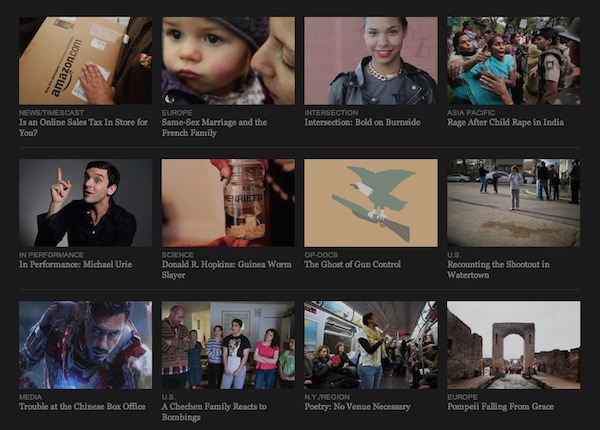

The New York Times is taking its videos over the (pay)wall. Starting today, all videos on NYTimes.com will be available to all readers, regardless of their subscriber status. Video views will no longer count against the 10-article monthly limit for non-subscribers. The video offerings will be free across all the Times franchises, whether you’re watching on desktop, mobile web, or through apps. The Times is opening up video thanks to sponsorship deal with Acura and Microsoft. (Shades of fellow car company Lincoln’s sponsorship of the Times’ paywall for 100,000 readers back in 2011.)
Video is a big point of emphasis for the Times and other news organizations, who recognize the far higher CPMs available for video ads against standard display — and who often find themselves with more video ad demand than they have videos to sell against. Arthur Sulzberger lists video as one of his four major areas of investment (alongside mobile, global, and social). The Times’ new(ish) CEO Mark Thompson, fresh from the BBC, has said he plans to increase video efforts. The paper has also re-aligned its staff for video, bringing on Rebecca Howard, formerly of AOL/Huffington Post, as general manager for video production and moving Rick Berke into a new position as senior editor and director of video content development.
“We recognize this is very important for audiences and recognize we’ve got to change the perception of The New York TImes as a place you just read to a place you watch,” said Denise Warren, the Time executive vice president of the Digital Products and Services Group. Readers have come to expect a video experience, Warren said, and as the Times produces more video content the paper has to make sure it reaches the widest audience possible.
One risk of the move is that placing video outside the paywall could create a confusing division between content forms. (Have all the David Carr and A.O. Scott you want on video, but read their words too many times and you’ll run into a wall.) What makes video different is that the Times aggressively spreads its video onto other platforms like Hulu and YouTube. When you make your content available for free on other sites but put up barriers on your own site, that inconsistency can cause problems, Warren said.
The move may not seem to line up with the Times’ commitment to (and success with) its paywall strategy, but the promise of greater advertising dollars may be too great to pass up. There’s a race on to create more video from news organizations: The Wall Street Journal has been growing WSJ Live, The Huffington Post is betting big on HuffPost Live, and The Washington Post is on the verge of launching a video channel. Warren said the CPMs for video ads continues to be higher than regular digital advertising, and wide variety of companies are eager to spend on video spots. On top of the potential ad revenue, moving into video also gives these companies a chance to take a foothold on new platforms, whether that’s tablets and phones or Xbox and Apple TV.
The best way to capture more video dollars is through producing more video, and the Times has been steadily ramping up its production and diversifying its programming. They’ve got features, mini-documentaries, live events, and hosted shows.
Warren told me they’re still in the planning stages for new shows and types of video. But we should expect future programming to continue to take advantage of the personalities on the Times staff as well as the franchises the paper has developed. (Maybe The Bits Show, or Up Late with FiveThirtyEight?)
“We have a lot of tools at our disposal to tell stories. We need to be aggressive about using all of them, and video is one of those important tools,” Warren said.